August 8th, 2022. So I’m off to Newcastle for four nights. OK. It’s not on the coast but surely it’ll be cooler than Hebden Bridge. Maybe the windows will open in my hotel, unlike in my apartment. But then again, maybe they won’t. Another hot hot week is expected throughout England with temperatures in the 90sF. I don’t think I’ve ever been to Newcastle even though Durham, where I did my postgrad studies was only a 15 minute train ride away. My closest friend in school had gone to uni in Newcastle but had graduated and left by the time I went to Durham. (Actually I discovered in my journal that Colin and I visited Paul at Newcastle uni in 1978 but I have no recollection of that trip).

My anytime return ticket was £50 so I set off as soon as I was ready and arrived in Newcastle exactly 3 hours from leaving home. It’s a bit far away for a day out but it was an easy journey, changing trains just once in York. It was very hot and sunny and lots of haymaking was in progress in the hinterlands of Yorkshire. It still takes me by surprise just how flat the land is in this area. I’d always associated Yorkshire with hills and dales but that shows the sort of landscape I sought out when I last lived in the north of England all those year ago.
Newcastle railway station was vast and a veritable treasure house of bars and coffee shops. It even had an M & S food court and a Sainsbury’s catering for all a traveller’s needs. I was really tempted to have lunch there but I wanted to ‘see’ the city and its famous bridges that I’d only seen from the train before. I headed out through the impressive arches of the station, stepping in the footsteps of Sting, to Jury’s Inn, a 7 minute walk away according to Google Maps. I’ve never stayed in a Jury’s Inn before, far too soulless for my liking, but it was close to the station, advertised a coffee bar (a possible breakfast venue) and a restaurant in case I didn’t feel like going out for dinner. There was no way I was going to pay £14 for my breakfast preference: cereal, toast and tea. As it transpired there was no way I was going to pay £15 for a hot dog for dinner either. And the coffee bar didn’t exist. The bar served coffee! That’s not what I call a coffee bar. My room was on the third floor and overlooked the central courtyard of a complex of apartments and offices.

I was travelling light and after hanging up a couple of things in the wardrobe I headed out into ‘the big city.’ I hadn’t been able to find a tourist information centre mentioned anywhere online and on inquiry back at the station I found out that there isn’t one.

The Civic Centre opened in 1967 
The River God, Tyne 
Grey’s monument 
St James’s Park, home to Newcastle FC and very centrally positioned 
High rise
I made for the centre of the city and within minutes it became apparent that this place is very different from Leeds and Manchester, the two northern cities I am most familiar with. In those places it seems rare to see anyone over the age of 35. This place was very much alive with people of all ages wandering around the predominantly pedestrian centre.
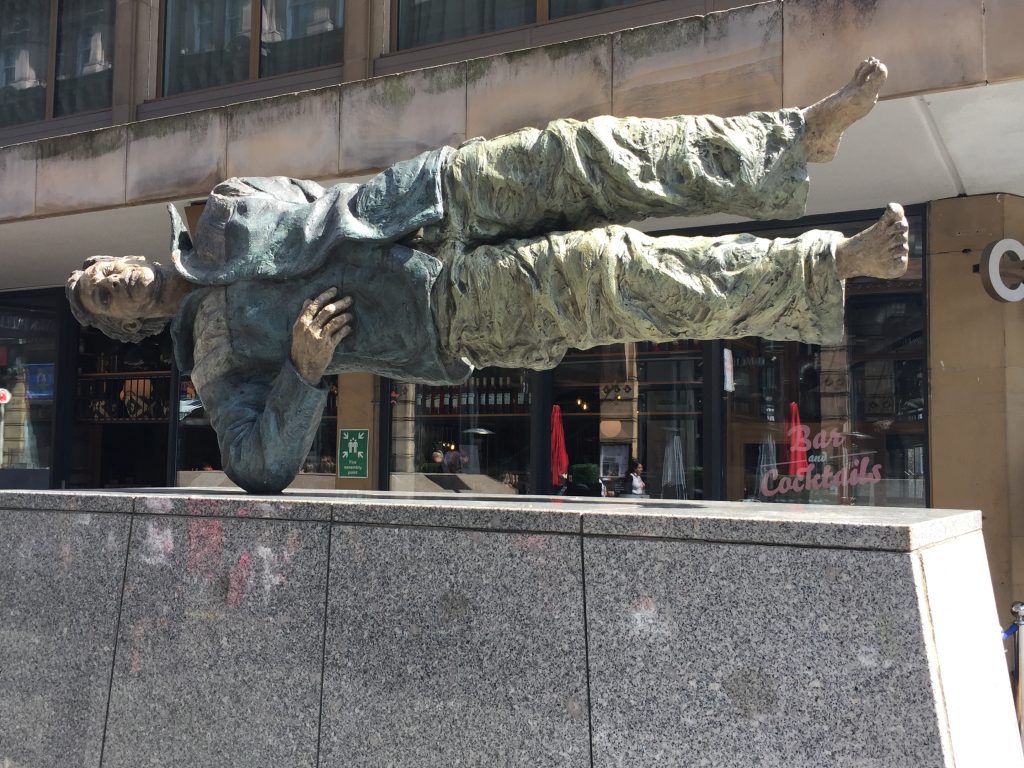
A few older historic buildings were wedged between bustling shops, the whole being looked down upon by Charles Grey, the second Earl Grey from atop a doric column 135ft high. It was built in 1838 and in 1941 his head was knocked off by a bolt of lightning. Earl Grey served as British prime minister 1830-1834 and possibly the tea is named after him. The vast shopping centre, Eldon Square was the largest shopping centre in Europe when it opened in 1976 on the site of the old town wall. With the high temperature I kept to the outdoors looking for a place to eat, outdoors but in the shade. It seemed that everyone else had the same idea and Newcastle isn’t equipped with much in the way of outdoor cafes. The days when they would be in demand must be very few and far between. After trying at least a dozen places I settled for a Japanese sushi place where all the tables were vacant – not a good sign – but this, the ‘Rolls-Rice of Japanese food’ provided me with a quite delicious meal and a pot of Oolong tea. On retrospect I should probably have opted for an Earl Grey, but I didn’t know of the connection at the time. I had already noticed several Oriental food markets dotted throughout the area, again, not something I had anticipated with my old fashioned view of the city. Also there were lots of supermarkets in the centre which brings people in to the centre and the bus station is adjacent to the Eldon Shopping centre. Most large towns I know have their supermarkets on the outskirts of town, necessitating a car to get there, leaving the town centres empty and abandoned. I always feel that Halifax is a ghost town after 6 o’clock in the evening. I usually like to photograph back streets and alleyways but in the centre I found little evidence of these.

After several abortive attempts to find a bus to take me to the river front, Quayside, I saw a Hop on Hop off bus approaching and jumped aboard, welcoming the breeze on the open top upper deck, and a sit down, having wandered around for several miles. The city centre surprised me. I’d expected a somewhat run down city. In fact, my choice of hotel had been governed by my mistrust of Aparthotels and Airbnbs on side streets – but this was my prejudice from my recollections of the city’s reputation 40 years ago. Instead I was confronted with a bustling metropolis of colourful, new, inventive architecture interspersed with a few historic buildings. The tour took me past the new castle. I didn’t know of its existence. I don’t suppose I’d ever considered the city’s name. But if this 1000 year old ruins was the new castle where is the old castle? Something to discover during my stay.


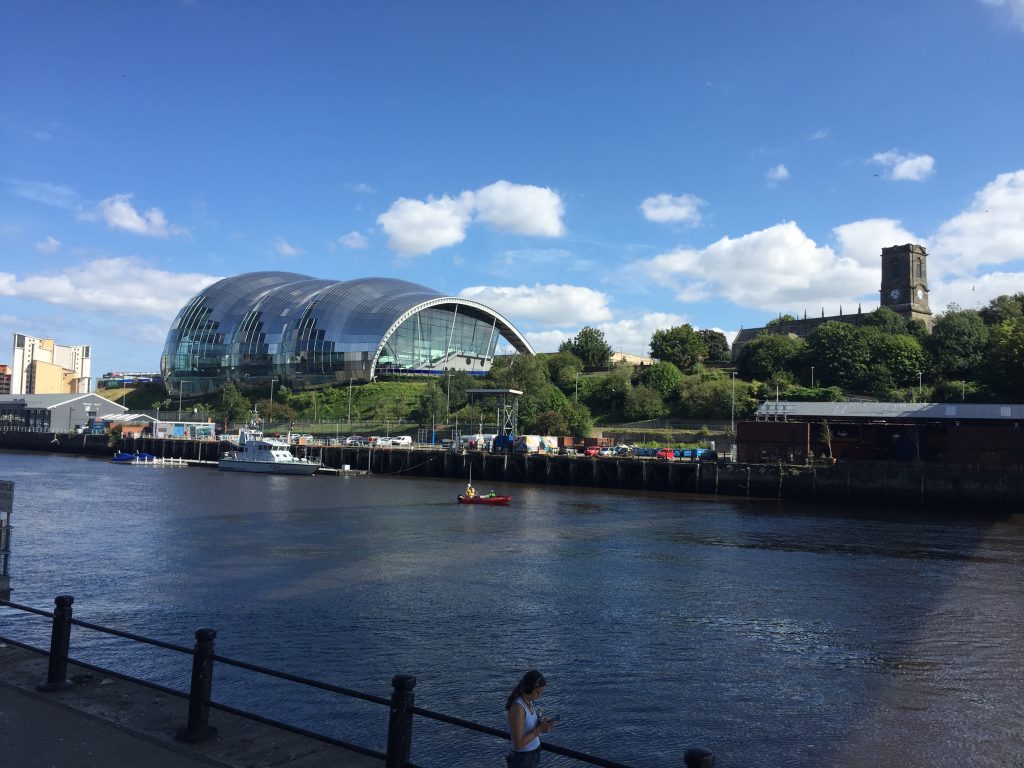
Open top bus ride, seeing the sites
From the running commentary on the bus I learned that the derivation of Gateshead was goat’s head and referred to the goat farms on that side of the river. We crossed the river Tyne twice and I learned that the 5 bridges (of the Nice’s 5 bridges suite) had now been increased by two. A pity – seven doesn’t scan! I’d expected an industrial landscape, shipyards, warehouses, preserved factory chimneys. Not at all. Passing over the swing bridge I could see a riverside walk on both sides of the Tyne with well patronised outdoor cafes and bars on this very warm summer evening. Elegant hotels now filled the former industrial buildings and the number of people strolling along the riverbank looked more like an Italian passeggiata than a northern city at play.

After the hour’s tour I spent an hour in the hotel decompressing, picking up the book I’d brought along for the trip – Alice Steinbach’s Without Reservations: Diary of an Independent Woman. I don’t know when I last read this book but it made a big impression on me. It wasn’t until a couple of days later that a piece of paper dropped out of it, something I’d written at the end of my month’s stay in England, so either 2016 or 2017. I had a shower to try to cool down a bit before heading back out to explore, now realising after getting my bearings from the bus tour that I could walk to Quayside quite easily. I’d picked out a waterfront restaurant for dinner simply based on its name: The Pitcher and Piano. At a pedestrian crossing the lights weren’t working and I got into conversation with a lady who advised me that The Pitcher and Piano was too far to walk and “far too expensive.” What that said about how I must have appeared to her is quite amusing. But I couldn’t find the place she recommended – Lloyds, and ended up in a Wetherspoons. All the outdoor tables were taken, as had been the case in all the previous eateries I’d passed, so I headed upstairs where I at least could have a chance at hearing myself think. It was an old building with exposed beams, thick stone walls and a tiled roof. I edged my way to a table with a view onto the river. I asked the waitress what the building had once been but she didn’t know. Later I found that it had been erected c 1515 as a warehouse, according to Pevsner.

Leaving the pub I walked further along the river, crossed the swing bridge and ended up in an outdoor bar almost under the Tyne bridge with its distinctive semi circular arch. This ‘hip brewpub’ is made up entirely of shipping containers in various stages of rusting.

They were set in a colourful garden and it was a delight to drink a glass of their locally brewed beer even though it was served in a plastic cup and cost 3.95 for a half pint! I don’t think I’ve ever paid more than 2.99 before. But what the hell! This was an amazing iconic landscape in front of me, and I was part of it. I really must listen to Nice’s 5 Bridges Suite, and some Sting – a local lad.

I retraced my steps amidst the cawing seagulls dive bombing me from the bridge’s girders. What? Seagulls? This was 10 miles from the coast.

I was to find the answer to that question at the Baltic Centre in a couple of days. I got a taxi back to the hotel. At 3 it was cheaper than my beer. I spent the evening searching online for bus timetables, opening hours, and made a list of things I’d like to do now that I had a feel for the place. There did seem to be quite a dearth of good tourist info. Perhaps all the people out there are locals. Later I watched the closing ceremony of the Commonwealth Games from another city which has changed dramatically since I knew it- Birmingham.

Day 2
I woke to a loud continuous noise issuing from the forecourt and into my room through the open window. I peered out. Men were using giant hosepipes to power wash the forecourt. Just my luck.
Still, I was awake now and settled down with a cup of tea and immersed myself in ‘Without Reservations’ for an hour before venturing out in search of breakfast and wondering what the day in store for me.

Two ladies in the lift were just coming back from partaking of their hotel breakfast which they were extolling for its vastness – bacon, sausage, baked beans, egg and toast. I couldn’t think of anything worse to begin my day so I trekked off to the railway station and ‘Destination 1850’, a small coffee bar where I was the only customer.

Last night I had made a list of things to do but many places were closed on Tuesdays so I decided to go and find the Angel of the North. As it happens an original piece of artwork of this iconic sculpture by Anthony Gormley took pride of place in the hotel corridor just outside my room. I’d always wanted to see this gigantic figure completed in 1998 and viewed by 33 million people each year due to its proximity to A1. It stands 66 ft tall and has a wingspan larger than that of a Boeing 757.

It was a half hour bus ride through Gateshead and its suburbs and soon I was standing on the A1 being buffeted by passing cars doing the maximum speed only inches away from me. But there it was, The Angel, and I explored the grassy bank on which it stands, ready to withstand a 100 mph wind – the angel, not me. A mobile coffee shop had set up camp in the parking lot and a dozen or so people were exploring the site. I felt compelled to touch the weathered steel. Impromptu memorials decorated the bushes surrounding the site the words of some bringing me close to tears.

Back on the bus I headed back into the city and got a picnic to go at M&S and then back to the hotel where the power cleaning was still in noisy process. A shrimp pasta salad accompanied my reading of a few more of Alice’s exploits in Paris and then it was off to The Discovery Museum which had been pointed out on the Hop on Hop Off bus the previous day. It was mainly set up for children and there were lots of them around, mostly with grandparents in tow, but I was surprised to see an army tank outside the entrance to the building. I thought for a moment that I’d been transported into Kiev.

As I stopped to take a photo a man came over to me. “Know where she was built?” he asked in that Geordie accent I love so much. “I’m sure you’re going to tell me” I quipped. Then it was ‘Where are you from?’ That’s a complicated question and depending on the circumstances I can give a one word answer or several paragraphs. “What do you think of Newcastle? Is it what you expected? ” He was 54, born and raised in the city. I fully expected him to offer to give me a personalised guided tour of his home town but ‘I have promises to keep. And miles to go before I sleep. And miles to go before I sleep.’
So what did I discover in the Discovery Museum?
1. The new castle was originally built of timber in 1080 by Robert Curthose, son of William the Conqueror and rebuilt in stone between 1168 and 1178
2. The old castle was a small Roman settlement and bridge built on Hadrian’s Wall around the year 200
3. In the 1600s a ‘Newcastle Coat’ or ‘drunken cloak’ was given as a punishment to drunkards in the city. They had to walk the streets wearing the barrel for everyone to stare and laugh at.
4. Eldon Square was the biggest indoor shopping centre in Europe when it opened in 1976.
5. There was a large ship the Turbinia was the first turbine-powered steamship. Built as an experimental vessel in 1894, she was easily the fastest ship in the world at that time.
I wandered through Life’s courtyard – a vast science centre opened in 1998 which houses both a science museum and ground-breaking research into regenerative medicine and genetics.

It also incorporates a cafe and two bars but its the colourful construction of the building itself that stopped me in my tracks, beckoned me into its shade for an iced coffee, before heading down to Quayside.

I’d caught a glimpse of a plinth in a beer garden from the top of the double decker bus and I thought I’d go and check it out. It was now passeggiata time and a cool beer sounded just the thing. In the garden every table was occupied and when I walked over to read the words on the plinth it was obvious from the looks I got that I have very much a minority interest – which suites me just fine. I was totally taken aback by what I read. The plinth is the centenary memorial, 1891, to John Wesley and read ‘Near this spot John Wesley preached his first sermon in Newcastle on Tyne, Sunday May 30th, 1742.

This founder of Methodism, who preached in Heptonstall, and, according to some sources actually stayed in Lily Hall, home of my ancestors in that village, would surely have turned over in his grave to see his memorial taking centre stage in a beer garden!

Continuing along the waterfront I passed deckchairs festooned with plastic flowers and then a sculpture of what I took to me an anti slavery piece but in fact it takes its

inspiration from a strongman and fire-eater who regularly performed here on the Quayside – the chain is another reference to his act – and the statue was intended to breathe fire. Unfortunately but understandably, the cost of safely maintaining a gas flame ‘was prohibitive.’ Next to come into view was the Blacksmith’s Needle. It was made by the British Artist Blacksmiths Association, with its constituent parts made at different forges around the country. The sculpture was unveiled in May 1997 by the percussionist Evelyn Glennie, who rang a bell, which hangs inside the needle.
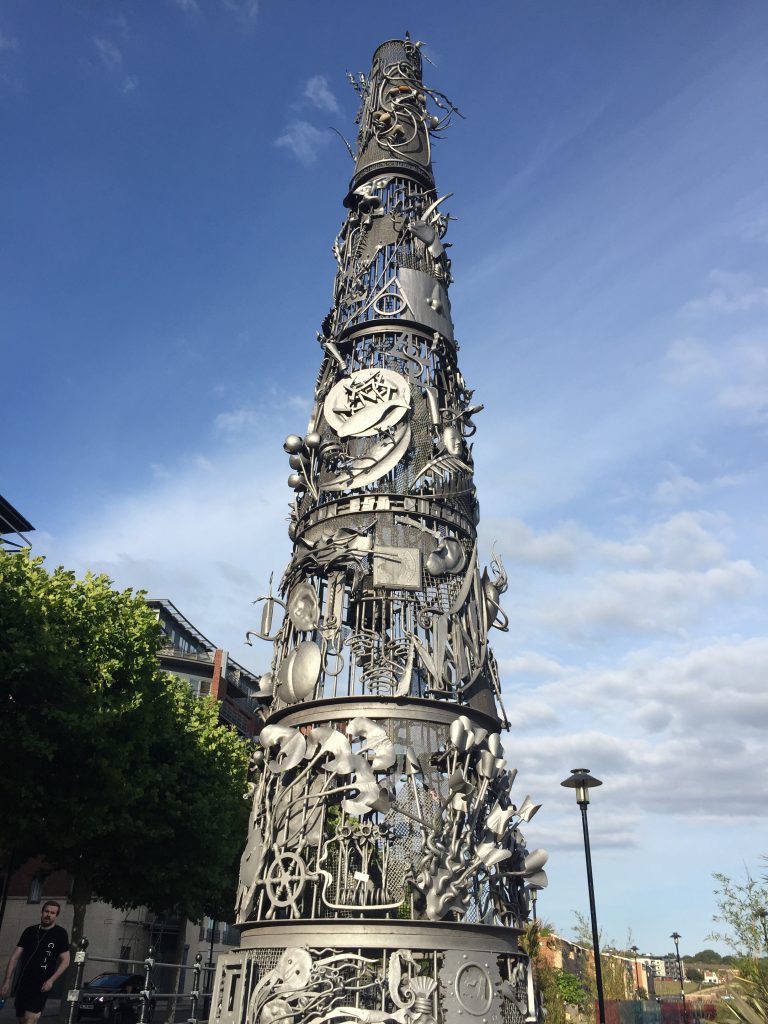
Oh my. I didn’t know that connection when I was there, and I couldn’t find an explanation of the piece, but I did see some music notation on it and took a close up photo. When my daughter was working in Santa Cruz she served breakfast to Evelyn Glennie when she was in town participating in the Cabrillo Festival of Contemporary Music.

I’d passed only one waterfront restaurant which had empty outdoor tables and I’d checked out the menu. It looked tempting so I retraced my steps and approached the maitre d’. “Table for one?” I inquired. “Sorry, we’re fully booked” came the reply couched in a beautiful Italian accent. I gestured to the dozen or so empty tables. “Really?” “Sorry, Madam.” “Oh, can’t you just fit me in. It’s just me and I won’t take up the table for long.” I turned on the charm. “With your lovely blue eyes how can I refuse your request?” came the smiling response and in no time I was sitting at a small table on a raised bank with a perfect view of the other diners, the evening strollers and the 7 bridges across the Tyne. Not being a foodie the name of the restaurant meant nothing to me. In fact Gino d’Acampo is a three Michelin star chef with seven series of Gino’s Italian Escapes on ITV with a cookbook for each series. He’s a regular presenter on TV cookery shows and panel shows and was crowned King of the Jungle in the ninth series I’m a Celebrity, Get Me Out of Here.Along the way in 1998 he broke into Paul Young’s apartment and stole guitars worth over £4000.

My table was adjacent to 2 others on which two men were also eating alone. I’m very conscious of going into pubs and restaurants by myself and can have great fun seeing what reaction I get. I set up a conversation with one of the guys, who was staying in the hotel, travelling for business. “Oh, I didn’t realise this is part of a hotel.” Apparently it’s called Innside. Its publicity states ‘Explore Newcastle’s most exciting new hotel, perfect for business and leisure. Indulge in art, music and culture with spectacular views of the Tyne and its bridges.’ Obviously I must have good taste. The hotel guest grew up in Newcastle and we discussed how the city has changed in the last 30 years. He’d stayed at The White Lion in Hebden Bridge just two weeks ago! So wrapped up was I in the conversation that I ordered a crème brulee and a second beer and eventually I settled back to watch the sky and river take on it ‘pink time’ colours as I listened to The Five Bridges Suite after chatting to Sarah and giving Daphne a glimpse of my spectacular view. “
Fantasia 1st Bridge” “2nd Bridge”
“Chorale 3rd Bridge”
“High Level Fugue 4th Bridge”
“Finale 5th Bridge”
The work was commissioned for the Newcastle Arts Festival and premiered with a full orchestra conducted by Joseph Eger on 10 October 1969. Written by front man Keith Emerson who left The Nice to form Emerson, Lake and Palmer, Keith was born in Todmorden, the next town along the Calder Valley from Hebden Bridge, after his family had been evacuated there in the Second World War. Although I knew the music of the album inside out I’d never paid any attention to the words. Now I wanted to read them and hear them because I’d seen the bridges, Northumberland street, Grey Street and St James’s Park.
FIRST BRIDGE
(Instrumental)
SECOND BRIDGE
Five bridges cross the Tyne
And the city sits close by
For some go north and some go south
But each one seems to cry
There’s no good complaining ’bout dirty air ‘cos there’s nothing much else to breathe
And it’s no good shouting from nine to five if you haven’t got the guts to leave
You do not want to leave
Then you make yourself believe
You’ve got something up your sleeve
Won’t you take a walk with me down to the Jesmond Dene
Very Green
THIRD BRIDGE
Take me to Northumberland Street
Where Northumberland people test their feet
On a pavement
On a crowded afternoon
And no one wants to change this
But I bet they’ll do quite soon
Take me to the new town hall
With the light show on the wall
In the evening
All crimson, green and blue*
Has your mother ever noticed?
Perhaps she will quite soon
Take me to St James’s Park
Where St James’s people park their feet
On a Saturday
United there they stand
Now everybody’s dad’s there**
With a bottle in his hand
Take me down to Grey Street
Where no great people ever meet
On Grey Street
It’s all too very calm
I don’t suppose you’ve been there
That don’t change the rule
For info about the making of 5 Bridge Suite:
https://www.keithemerson.com/MiscPages/2009/20091006-FiveBridges.html
A brief taxi ride got me back to the hotel where I listened to Side two of the album – Emerson’s arrangements of Sibelius, Beethoven, Bach and Dylan.

DAY 3

Today I was the castle’s first visitor, climbing up the stairs to the Black Gate precisely as the cathedral clock struck 10. I had presumed that it was given its dark name after its colour, blackened by industrial grime. But no. It was named after Patrick Black who became Prince Charles’s tailor in 1613. When Charles became king Patrick was sent to France with £1000 to buy material for the coronation robes. A replica of the famous painting of King Charles in his regalia shows a very dandified-looking man clothed in black robes, white satin and lots and lots of ermine and the biggest bows on his shoes you ever did see.

Another plaque was, surprisingly, a photo of ukulele playing George Formby who made his first public appearance in Newcastle in a pantomime. He became famous during the 1930s and 1940s and was a great favourite with my parents. I remember the ‘When I’m cleaning windows’ song being sung in our house. The rest of what’s left of the castle is on the other side of the railway tracks. The castle had been reused as a fortress during the Civil War but pubs and taverns and many of the city’s cobblers made their residence inside the curtain walls of the castle.

Before long, it housed a series of tightly packed slum houses known as the Castle Garth which remained and when George Stephenson was constructing his railway bridge in 1847 many people wanted to demolish all evidence of the castle but a group of historians fought for its retention and the railway had to rebuilt around the castle. I rather enjoyed looking from a window from which arrows would have been launched and seeing the sleek body of an Avanti train edging its way along the track like some giant millipede overlooked by a giant stick insect, commonly known as a crane!
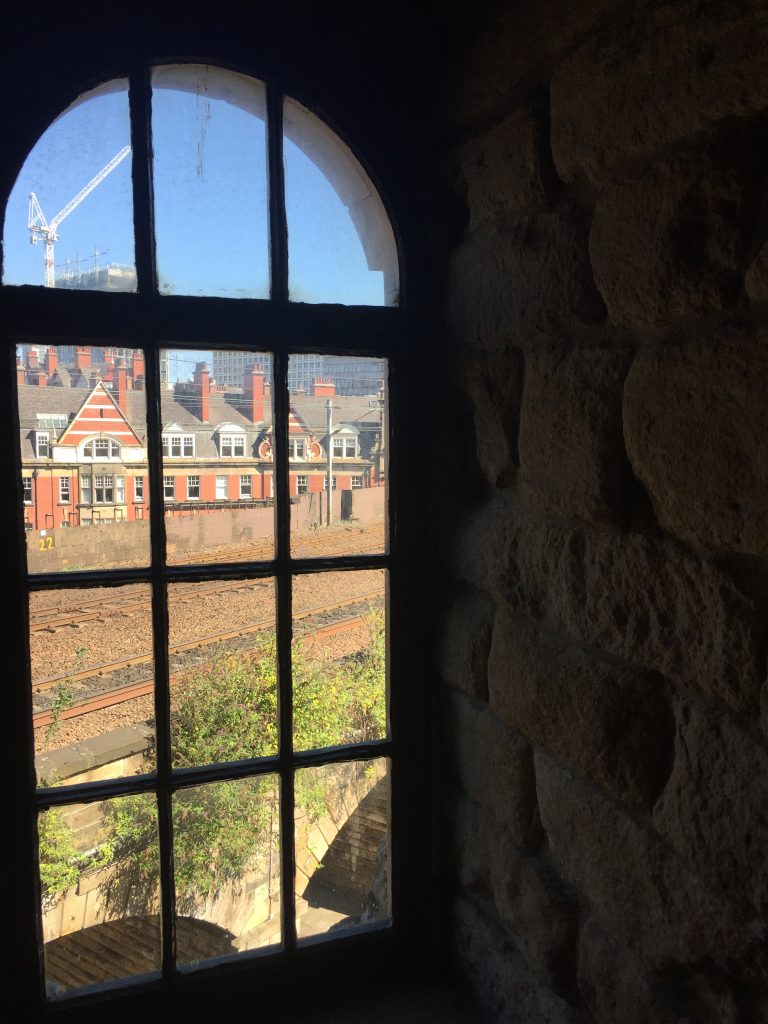
So off I trotted under the railway viaduct where the outline of the Roman fort is preserved in the cobbles and climbed the stairs into the castle keep. The thing that drew my attention was the amazing vaulting with its decoration. Richard l spent a winter here in 1292, sitting in the 43 ft high Great Hall. There was a splendid chapel too, and a cellar with its own fresh water supply, which was later used as a prison.

One notable prisoner was Mary Bruce, sister of Robert the Bruce from 1310-1314. Ha! The first school I taught at in Bedford was called Robert the Bruce Middle School. The flooring of some of the passages was very uneven and with little daylight I had to be very careful where I placed my feet.
I climbed the stairs all the way to the top of the Keep. At one point a sign read ‘only 99 more stairs to the best view in Newcastle.’

Emerging into the top of the tower I came face to face with two knights in shining armour. Actually their armour was a little rusty, but they didn’t mind. They were too busy concentrating on getting the necessary trajectory to be able to hit the train below.
But enough of this excitement. I needed to cool down before my next adventure and found the perfect spot at a Greek cafe with outdoor tables shaded by large umbrellas – the perfect choice for my elevenses. And then it was on to Durham.
The express X21 takes an hour to reach Durham, a place I’d not been back to since doing my postgrad studies there, though I’ve passed through on the train which gives a wonderful view of the cathedral and castle on the skyline. I could have made this journey by train in a quarter of the time but the bus travels through the villages where I can see the local pubs, little grocery stores, pretty, or not no pretty, churches and see more of people’s day to day life in the centre of their communities. I passed through Chester-le-Street, which I’d heard of and Pity Me, which I hadn’t. Of the many entomologies I found the one I prefer is the story that the coffin of St Cuthbert was dropped near Pity Me on the way to Durham, at which point the saint implored the monks carrying him to take pity on him and be more careful. The bus dropped me off across the river from the hill on which the castle and cathedral stand sentinel to the religious and political vagaries of the centuries.
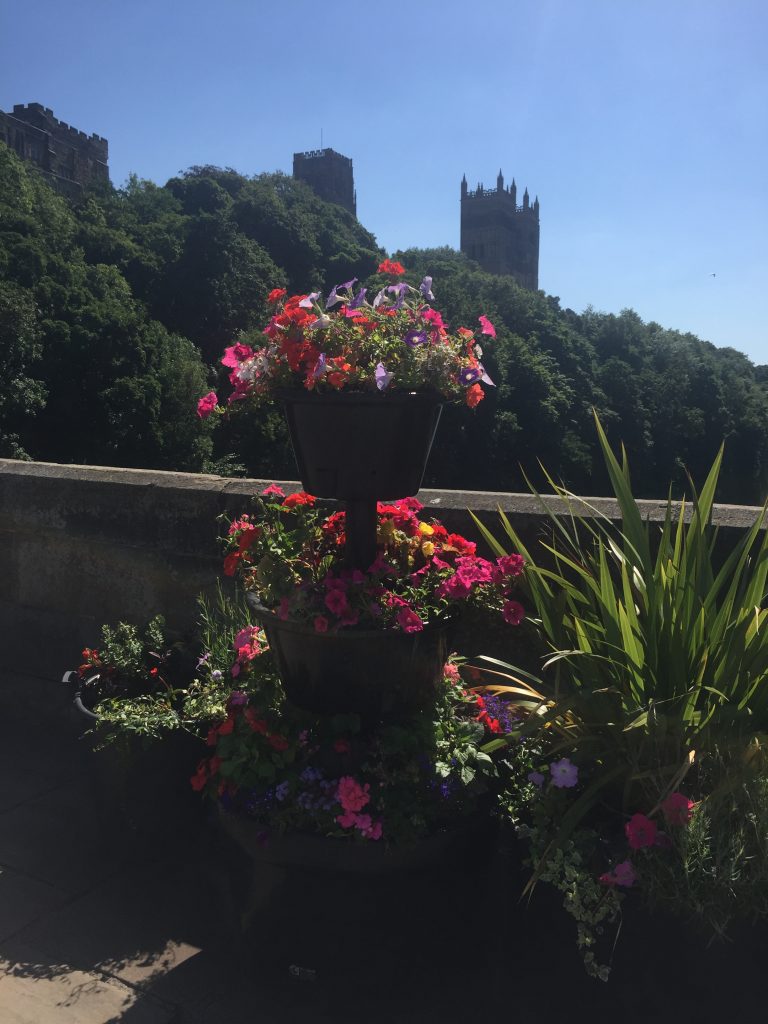
The town was packed with tourists. Unfortunately I’d missed the boat – literally.

The last one hour boat trip of the day along the River Wear had already departed so I wound my way ever upwards towards the cathedral. I recognised some of the street names but little else. But apart from a dozen or so photos, mostly of views of the river and cathedral in deep snow, and one of me and one of Colin outside my dorm at St Mary’s college I have little mementoes of my nine months there. Today the cathedral was my first destination and I remember having afternoon tea there occasionally but I think that was in a building on the cathedral green back in the day. I also have a recollection of walking close to some ancient tall buildings at dusk and being bombarded by bats.
As I entered the cathedral I just couldn’t believe how vast it was. I mean I was totally blown away by its size. Both St Cuthbert and St Bede are buried here and a few modern sculptures and new stained glass windows have taken up residence in the last 40 years. One thing that particularly drew my attention were with thin, tall black marble columns covered in fossils that were supporting the vaulting. I asked a ‘Welcomer’ if she knew what the fossils were. She didn’t but she told me how much she relished the question. “Most people just ask me where the toilets are,” she laughed. But not being able to give me any answer she referred me to Norman, the chief archaeologist who was working on an ancient door. Apparently it’s a fossil coral and was extracted from the bedrock of the River Wear further upstream.
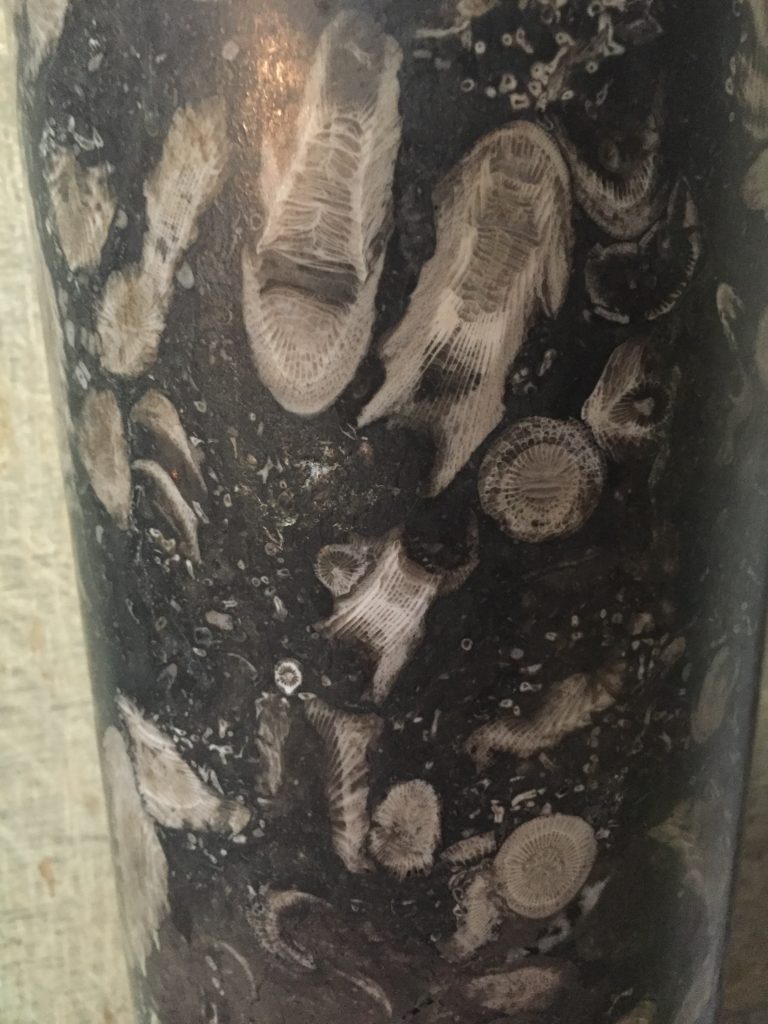
He also directed me to a large circular stone in the centre of the cloisters telling me about the crinoids visible there. The cafe is now in the cloisters and I sat there in the shade, relishing my mackerel salad with a world class view. I thought of how much it reminded me of the cloisters on Iona. The cloister garth was used extensively as a filming location for the Harry Potter movies. In fact, Durham cathedral was Hogwarts.

Mackerel salad . . . . 
. . . . and my view as I ate
Next I went to take a peek at the monks’ dormitory with its original 15th oak beamed roof. Another Welcomer greeted me and we were astonished to find that we’d both been on the same PGCE course at Durham in the same year, though we didn’t know each other. He’d done his teaching practice in Hartlepool and when I mentioned that I’d done mine in Easington Lane he immediately grasped the difficulties I must have had with the Elemore pit, the lifeblood of the community, closing down that same year creating mass unemployment in the town.
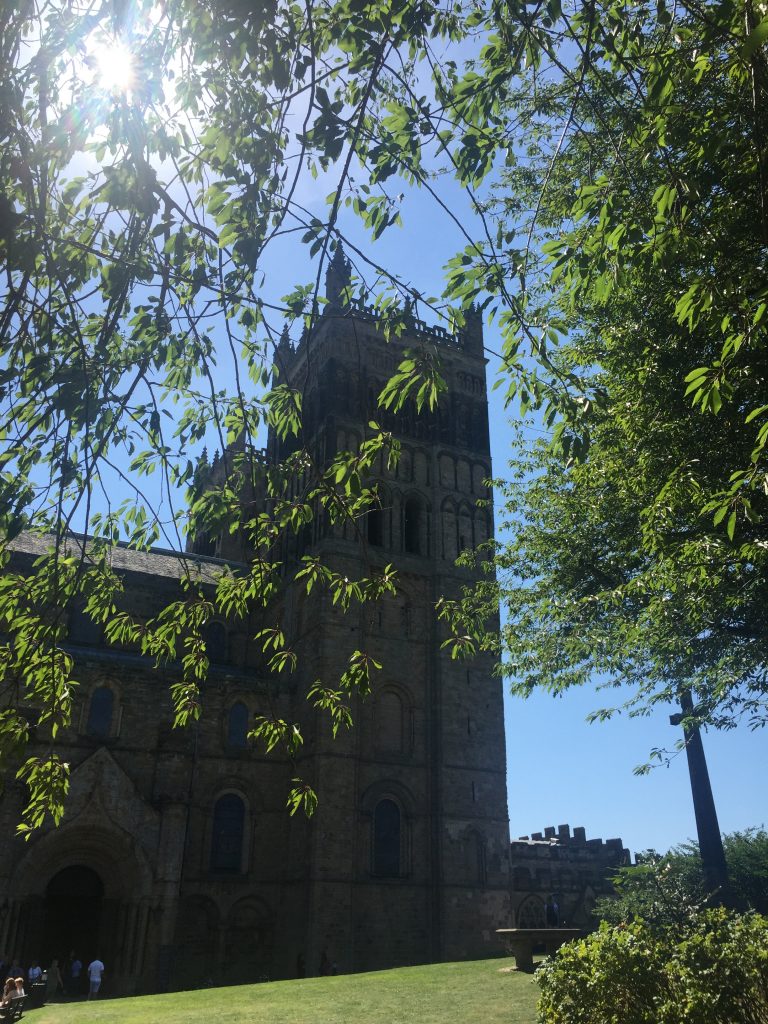
He told me that when were students at the uni there were 7,000 students. Now there are 40,000 – that’s more than Newcastle which has 35,000. That’s hard to comprehend, especially when the town was so packed today and all the students were not in college. There’s also a Japanese College on the same site as St Mary’s. And when we talked about the recent changes in Newcastle he mentioned the influx of people from Japan who came over to work in the car industry. The Nissan factory was built in Sunderland in 1984. Just as I turned to leave this magnificent room it hit me that my parents had visited this place, before I came to Durham I think. And for the strangest reason I seem to remember them actually staying in this room. (Later at home, rooting through some journals I found a reference to my parents visiting 8 years before I went there on one of their road trips).
I walked past the castle which has been the home of one of the University College since 1837 and waited for the bus back to Newcastle and rather than wait an extra half hour for the express bus I took the stopping bus, simply because I was so uncomfortable waiting in the hot sun. The journey back was a nightmare taking one and a half hours in which I totally melted!

California’s high – 75 
Newcastle’s high – 85
It was straight back to the hotel to bask in a cool bath (not big enough to lie in) and I came out feeling somewhat refreshed. The next big challenge was what to do for supper. Gino’s was fully booked and I fancied Thai food because I’d noticed a Thai restaurant in Durham but it was too early for dinner just then. I checked online and found a Thai Takeout just across the road from my hotel. I called them to make sure it was open and considered getting a takeaway but I thought I’d go over and check to see if it had any outside dining area.
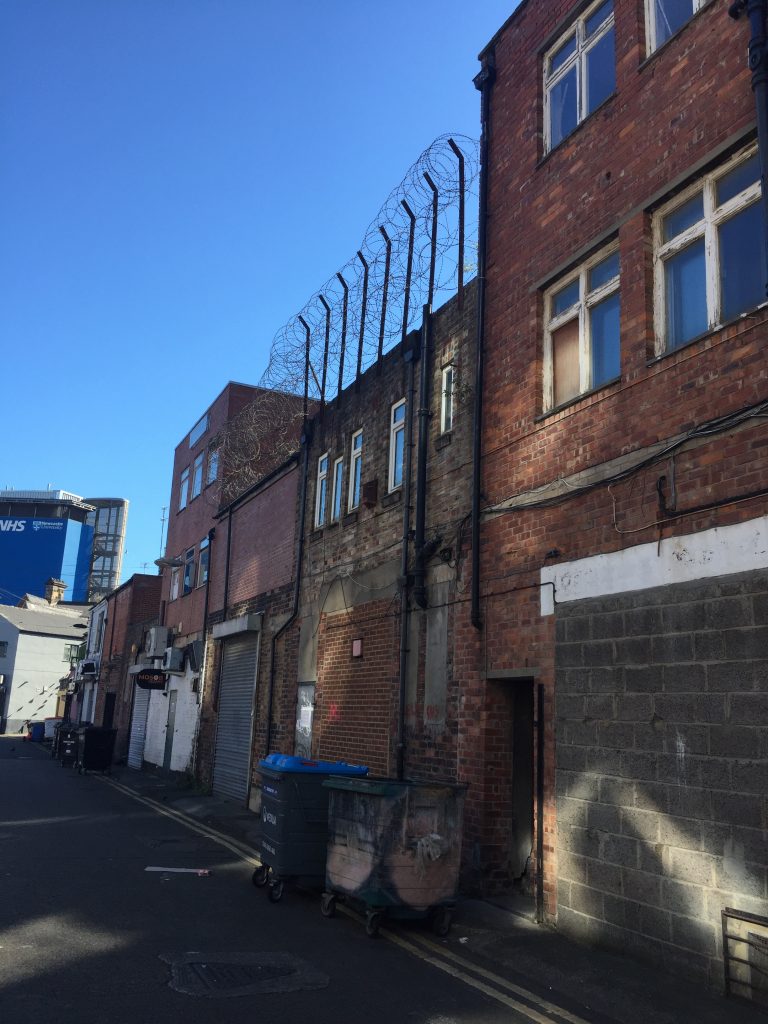
The row of shops where I thought it should be all looked as though they’d seen better days and several were permanently closed but even though I walked up and down the row twice I couldn’t find the Thai place. On the corner was a pub and I asked a couple sitting at an outside table if they knew of it. No, they didn’t and they were locals. So I called the place again. “We’re a click and collect only and our door is round the back of the shops. I’ll come and get you.” And within 2 minutes the man appeared and steered me round to the back of the building where a rather dubious looking door led into a room, but I wasn’t allowed in. He brought me a menu outside and I ordered and he told me it would be ready in 10 minutes.

I wandered back round to the front of the pub feeling somewhat uneasy in this back street. True to his word within 10 minutes a text appeared on my phone. My food was all ready to collect. Quite an adventure. I took it back to my room and tucked into my lovely dinner while watching a film about the life and career of Marin Alsop, the famous conductor who had been the director of the Cabrillo Festival in Santa Cruz and so I’d spent many hours watching her rehearse and conduct the orchestra, give conducting masterclasses as I review her work for various papers and magazines.

It was delightful to have a little bit of Santa Cruz with me in Newcastle. This was followed by Episode 1 of the new series of Shetland, which was the series that led me to go on a vacation to the Orkney and Shetland Isles in 2017 before I moved back to live in England. I love the scenery but find the plot line often difficult to follow. I need subtitles for Douglas Henshaw’s accent!
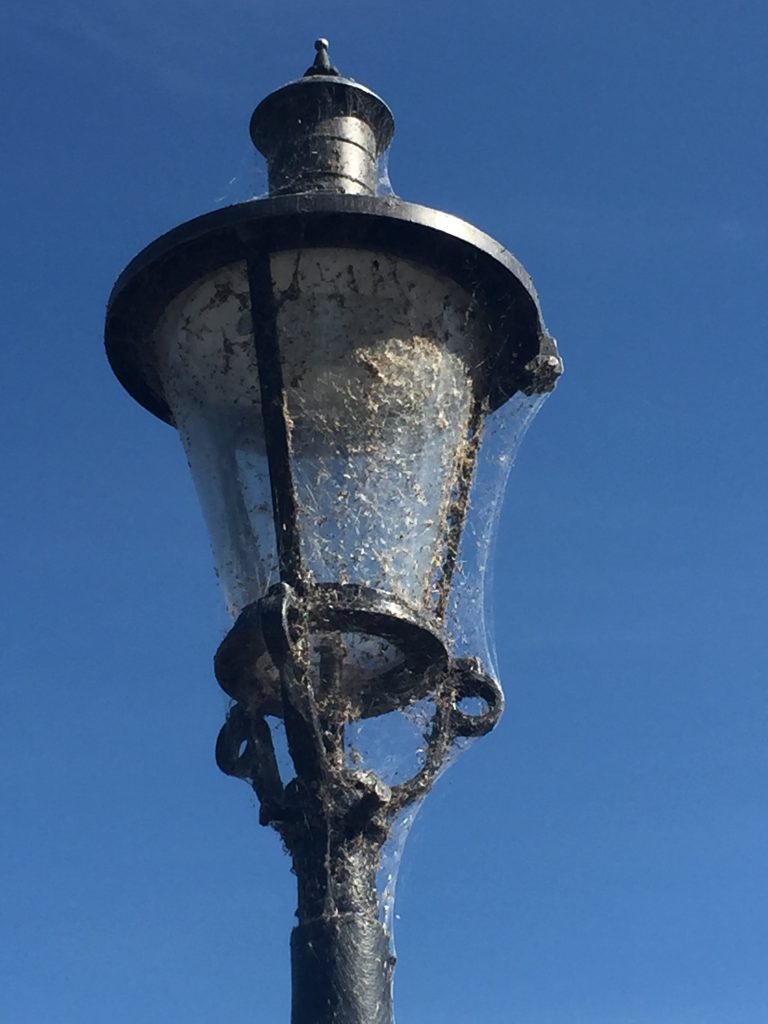
DAY 4
I’m sitting at a table outside The Baltic, drinking free tea. I need to move every so often to stay in the shade. To my left is The Sage, landmark venue for music and concerts, home of the Northern Sinfonia and closed for the whole of my stay here. For some reason its curving steel roof reminds me of a snail, or possibly a shell-less slug with its creased body as it manoeuvres. It rises from the river bank on a grassy hill and there’s a lot of construction in progress to its rear. I’ve been considering coming to Gateshead to a concert here sometime, and staying the night. Now I know the lie of the land I’m much more inclined to actually do it. There’s even a Jury’s Inn just next door.

It was another ridiculously hot day and I had purchased my yoghurt from the station and headed off to the castle to eat my breakfast picnic outside the Black Gate of the castle just like yesterday.

Then I set off to cross the High Level Bridge on foot, having been across its lower deck on the bus. I was immediately set upon by seagulls but the few locals walking over the bridge in business suits hardly noticed them.
Actually they are kittiwakes, something that I was learn from a notice on the viewing platform at The Baltic. When the reconstruction of the flour mill into a wonderful arts centre was under way in 1998 a temporary tower was built to house the displaced kittiwakes. Newcastle has the UK’s highest population of inland ‘seagulls.’ The High Level bridge was the world’s first combined road and rail bridge and was opened in 1849. The trains run along the upper deck so during my traverse a deafening rumble pierced the gentle sound of the morning road traffic inches away from me, from time to time.

There was less graffiti than I expected and to walk between the giant girders and ancient street lights was quite an experience. I paused for a moment half way across to look out at the swing bridge and the Tyne bridge. A boat was approaching the swing bridge and I hoped it would necessitate its ‘swinging’ but it was able to pass beneath the red and white span.

Actually they are kittiwakes, something that I was learn from a notice on the viewing platform at The Baltic. When the reconstruction of the flour mill into a wonderful arts centre was under way in 1998 a temporary tower was built to house the displaced kittiwakes. This is the UK’s highest population of inland ‘seagulls.’ The High Level bridge was the world’s first combined road and rail bridge and was opened in 1849. The trains run along the upper deck so during my traverse a deafening rumble pierced the gentle sound of the morning road traffic inches away from me, from time to time. There was less graffiti than I expected and to walk betweem the giant girders and ancient street lights was quite an experience. I paused for a moment half way across to look out at the swing bridge and the Tyne bridge. A boat was approaching the swing bridge and I hoped it would necessitate its ‘swinging’ but it was able to pass beneath the red and white span.
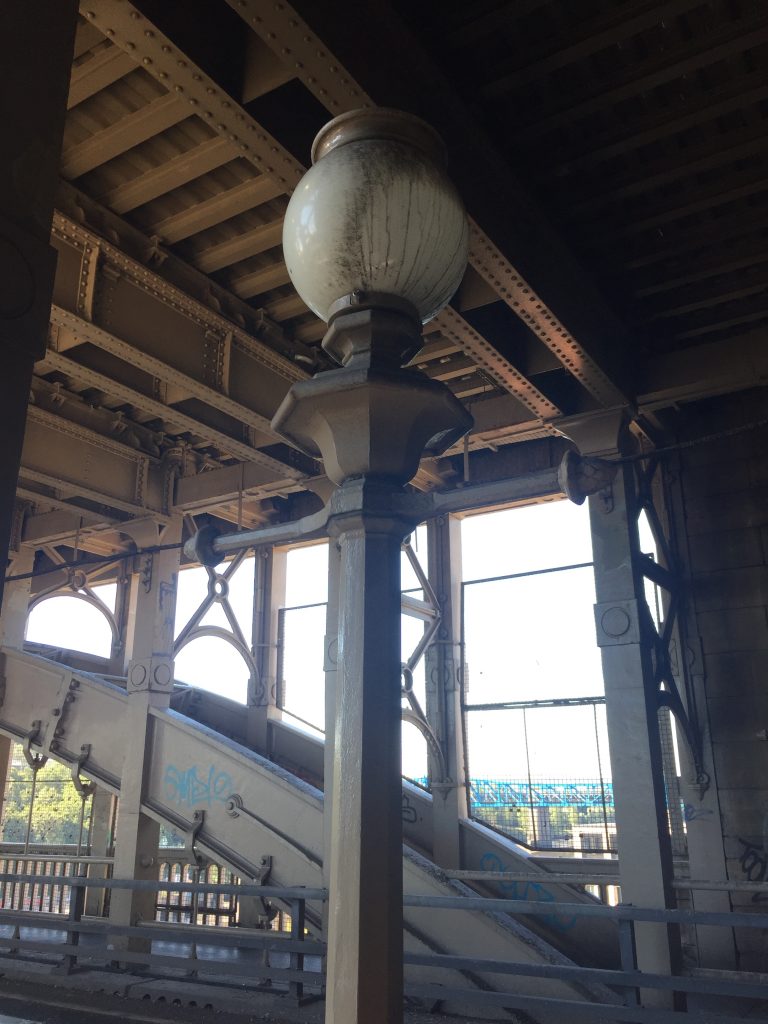
Back on dry land I found myself in Gateshead and I passed a stone violin commemorating the life of the world famous (not in my books) fiddle player, James Hill of Bottle Bank. Bottle bank was actually the name of the street cascading down to the Tyne and my great great great grandfather was named James Hill.
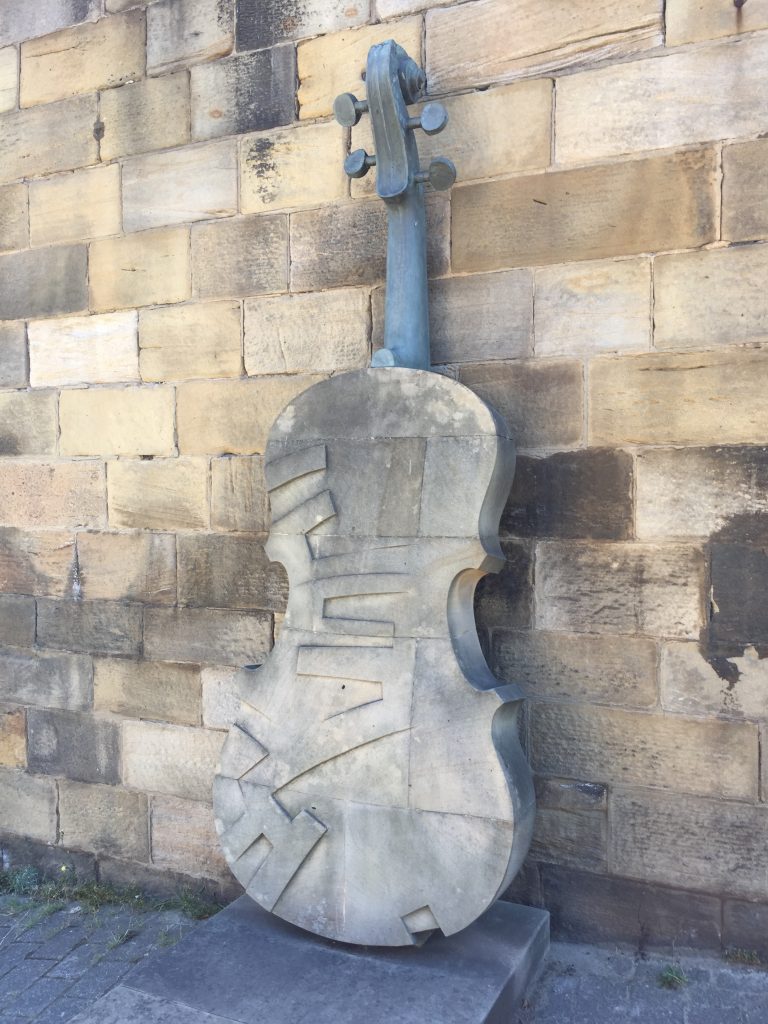
A blue plaque on a wall nearby told that Daniel Defoe, author of Robinson Crusoe and Moll Flanders lived in Gateshead 1706-1710, in Hillgate where I was standing. In his lesser known book ‘Tour through the whole island of Great Britain’ he describes in great detail the lives and hardships faced by people living in the Calder Valley. In the the second of his journeys through the area, Defoe described the difficulties he experienced in coming down Blackstone Edge in a snow storm, during which he almost lost his life.

On arriving at the base of Blackstone Edge he then described the route along the still undulating valley with its houses interspersed throughout. He also gave one particularly gruesome account of the Halifax guillotine in use.

Anna’s head and mine at the Halifax gibbey 
I walked past the entire length of The Sage with its reflective windows and then on to the old flour mill. It opened as a flour mill in 1950, employing around 300 people. The building is 138ft tall with a wing span of 79 ft and the building still contains the grain hoppers which run almost the height of the entire building.

It closed in 1981 and it wasn’t until 1994 that it was converted into an arts centre after an international architecture competition. Its six storeys high and each storey has immensely high ceilings. All the exhibits are contemporary and related to climate change and women’s role in society throughout the world. Some knitted lampshades and giant fabric banner of mythical beasts in particular caught my eye. The lift ran along the outside of the building and was glass.
It took me a few attempts to be able to look out as I ascended to take a look at the 6th floor restaurant. This must be one of the best locations to have a meal in the area since its all glass, but today it was absolutely stifling and only one table was occupied. So I settled for a seat in the ever diminishing shade in the forecourt and enjoyed the free tea and a croissant. I asked the barista if this was the only museum in the world to offer free tea with as many refills as required but she didn’t know. “I know people from other countries are always surprised that the gallery is free,” she told me. Like the rest of the places I visited the centre was mostly being viewed by grandparents taking out their grandchildren during the school holidays and I find that difficult to accept that I’m so far away from my children and grand daughter. I went back inside the building to continue my exploration noticing a plaque commemorating the honorary patrons of the building who include Bryan Ferry, Sting, Yoko Ono, Melvyn Bragg and Antony Gormley. In the children’s discovery room I found a wall covered in something like aluminium foil which produced wonderful reflections. I took an obligatory selfie and posted it on Facebook with the title ‘Melting in The Baltic.’ A friend took me seriously and asked if I’d had a nice time on my cruise! Another quote I saw in the foyer was ‘A Gentle reminder to look longer, think deeper and take the long way home.’ I think this reinforces the sentiment of the Alice Steinbach book and also’Away and Aware – a field guide to mindful travel’ that Anna sent to me last week.

With that in mind I took the ‘long way’ back towards my hotel, crossing the Millenium bridge and then climbing through the flights of stairs through treelined streets of old cottages juxtaposed with high rise offices above Quayside. It was while thus occupied that I came across All Saints church with its slim tall tower exuding a certain elegance.
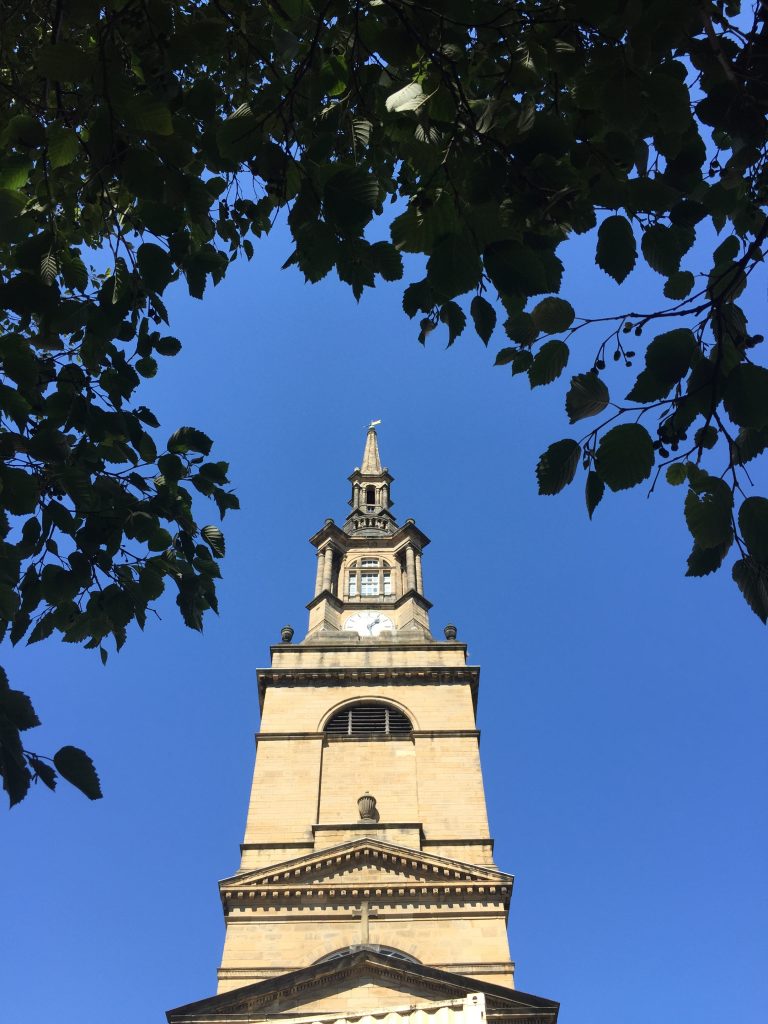
A plaque outside told of its construction in the 18th century and that it is the only elliptical church building in England. Then it said that the church had been deconsecrated in 1961 and used as offices and a rehearsal studio for the Northern Sinfonia before they moved over the river into their present home at The Sage.In 2009-11 it suffered catastophic floods and was left in a state of total disrepair A group of people were having a picnic on the steps. “What is it now?” I asked. They looked at me as if I’d flown in from another planet. “A church – duh.” The door was open so in I went. Yes, indeed, so in I went, picking up a guide leaflet and admiring the round church with its beautiful woodwork. It’s now a Presbyterian church and is only open 3 hours a week, and I happened to have walked up its doors in this small time window. Sir John Betjeman, the former Poet Laureate, described it as one of the finest Georgian churches in the country. The plaster ceiling above the nave is more reminiscent of a stately home than a church. No pillars support the roof and a balcony runs around the entire circular body of the church. The whole interior is very light with large windows – from which there is a great view across the river. https://www.icysedgwick.com/all-saints/
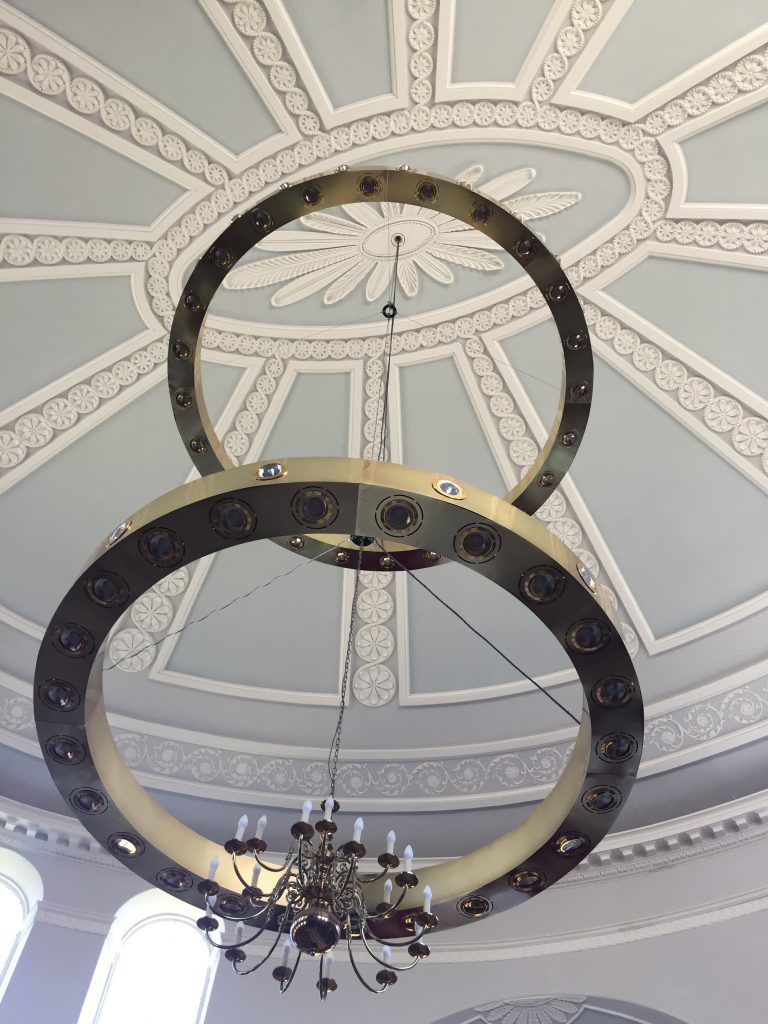
I’d booked a table back at Gino’s for this evening’s meal and I took a new rout down to Quayside, down lots of flights of stairs leading down from the level of the High Bridge down to the waterside. I arrived at 6:15, 15 minutes early and asked to be seat outside. “Sorry. The outdoor tables are all booked,” I was told. You need to go inside and check in. Inside the restaurant it was not only packed by more importantly extremely noisy.
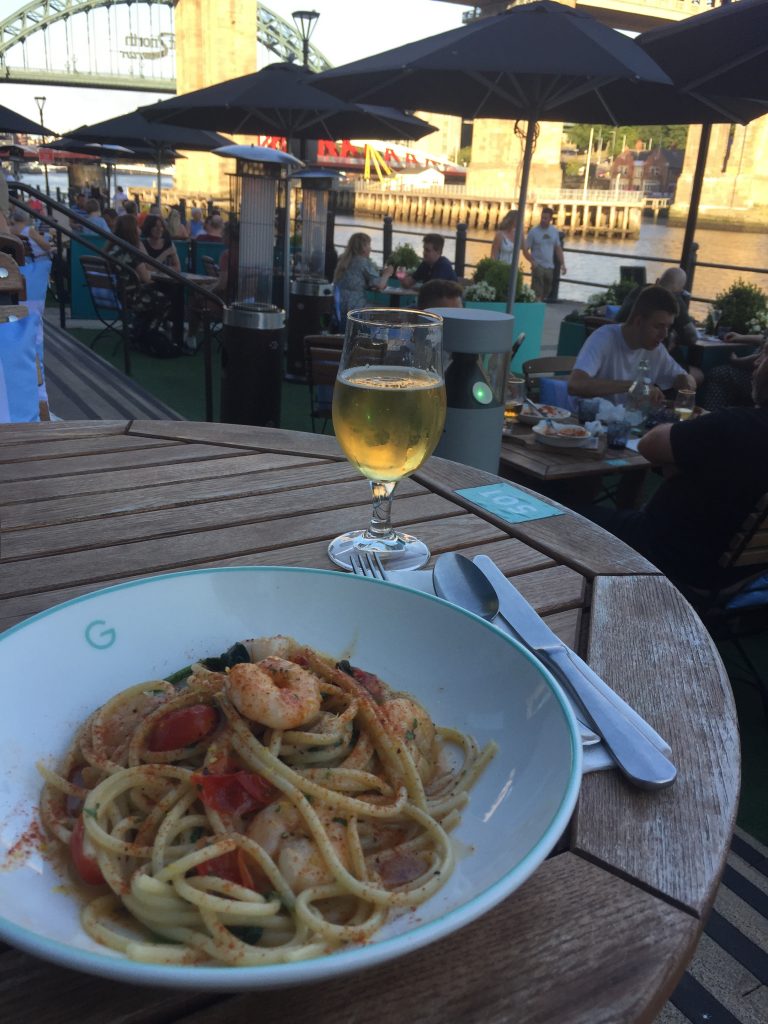
“I’d like to sit outside where I sat last night- table 503” I said to the maitre d’ making me sound like a regular customer. “No problemo. Just wait until I set up the table for you.” Ha! I had a lovely meal of jumbo prawns and spaghetti and at one point last night’s maitre d’ came over to my table to welcome me back. I guess it pays to be persistent.

DAY 5
I had an opened ended train ticket back to Hebden Bridge but once I know I’m leaving a place I like to get on the road – or in this case, the tracks – so I packed up and walked to the station, the temperature being expected to reach even greater heights in the course of the day. I thought of the photo of Sting in the very spot where I was standing.
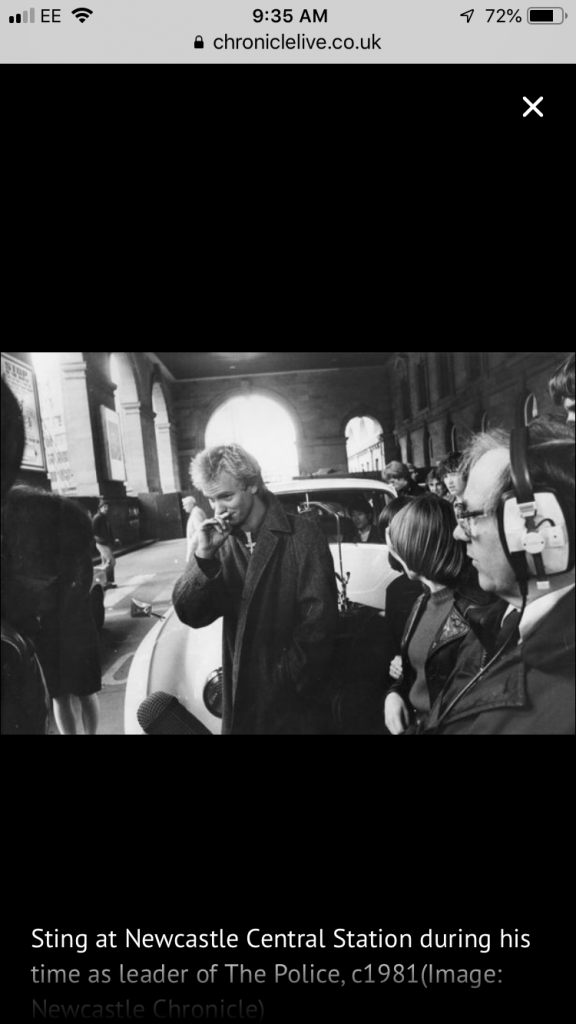
I bought a few snacks for the journey and went in search of my platform. It was packed. I couldn’t even get onto the platform. It turned out that a previous train hadn’t yet shown up due to a problem on the line north of Newcastle (Where have I heard that before??) and then people had also arrived to board the next train. I went to sit on a quieter platform and people watch for a while. I then noticed that the train parked on my new platform showed ‘Darlington’ as its destination. Or was it? Perhaps it was to pass through Darlington on its way to Leeds, my destination. No destinations or routes were showing on the overhead signs on the platform but eventually I found the train driver. Yes, we’re going to York but not until after two other trains leave. I had no problem with waiting if if meant a less crowded train. I was able to board and wait the half hour until it was due to leave. Meanwhile I could see the crowd on the other platform increasing in size by the minute.
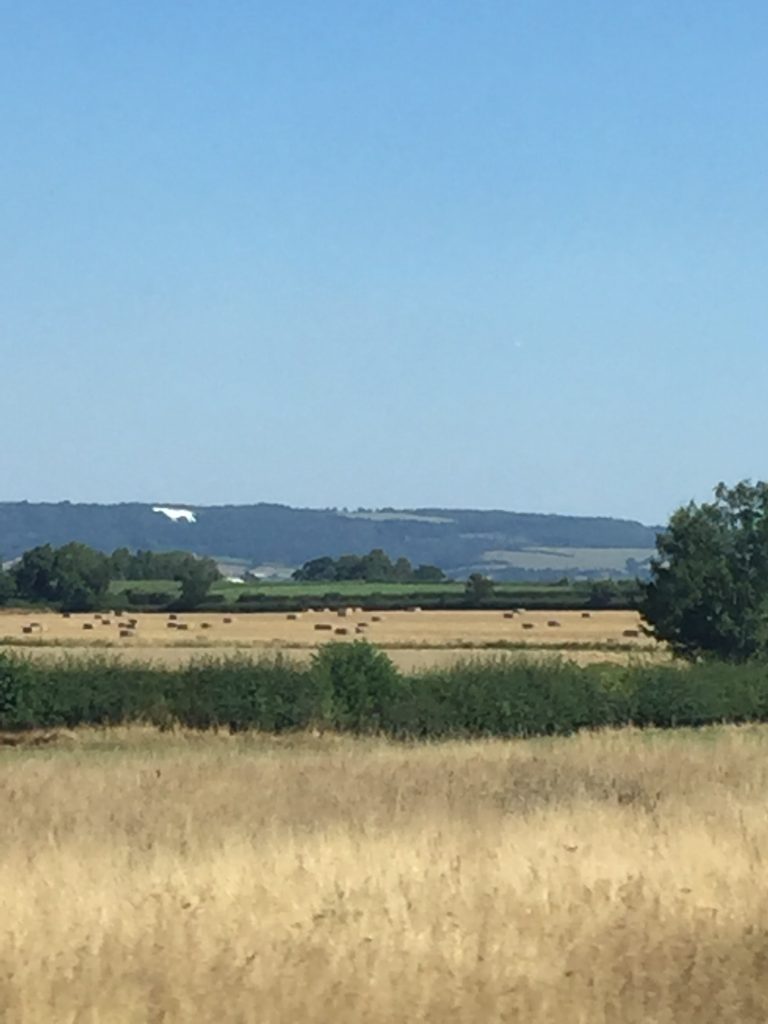
The time came for us to depart. We sat. We sat. At last we were told that there was a problem with the train and the driver needed to turn off the engine – and the air conditioning – to fix the problem. Half an hour later we set off and had a nice trip to York, passing the White Horse at Kilburn, covering 1 ½ acres, cut into the rock and then covered with white limestone chips created in 1857 although who was responsible is disputed. I changed trains at York and having boarded the train an announcement told us that, after Leeds, the train would not be stopping in Bradford or Halifax. In fact, our next stop after Leeds would be Hebden Bridge. I couldn’t believe my luck. It was 2 o’clock as I walked across the park into town. The severity of the heat was apparent in the fact that the park was almost completely devoid of people apart from one man who seemed determined to offer himself up as a fried human being!












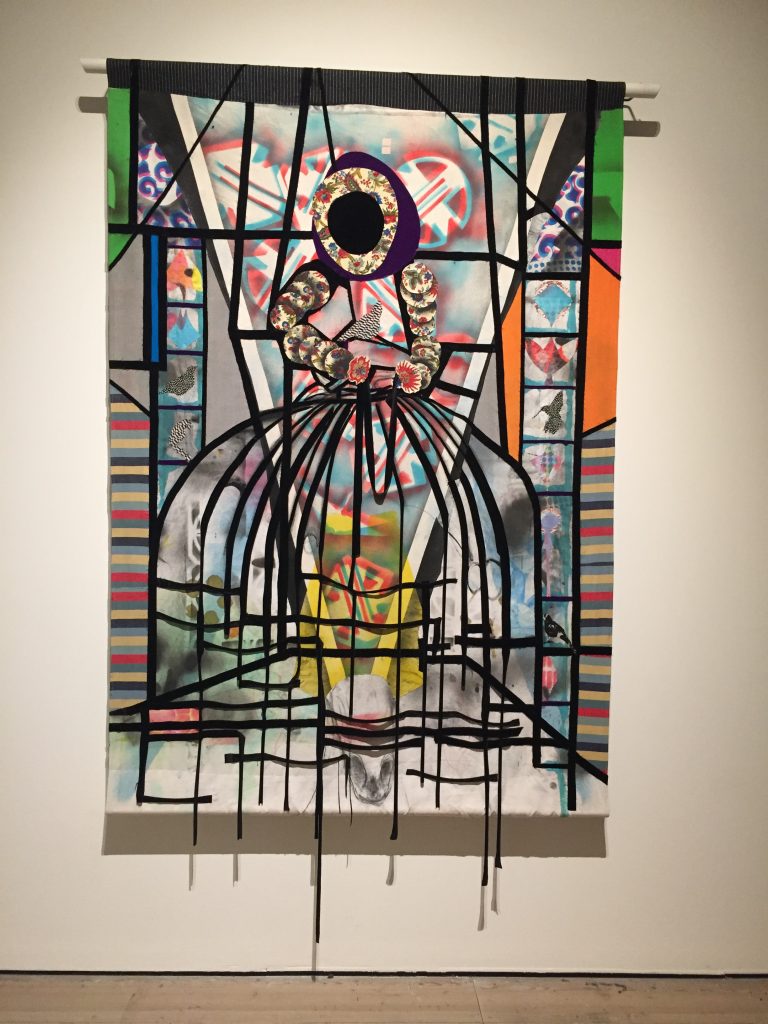

21st August 2022 at 9:54 pm
Really enjoyed reading this!